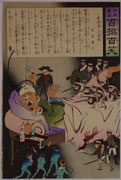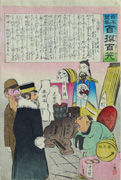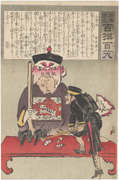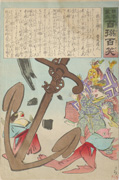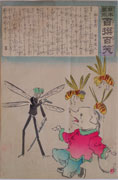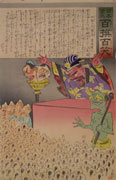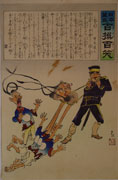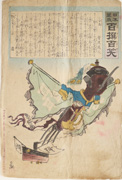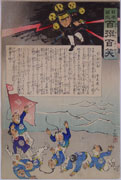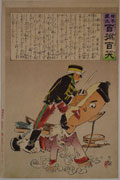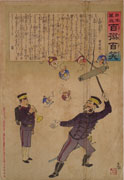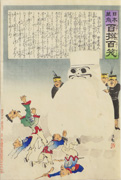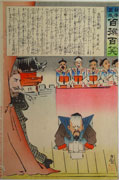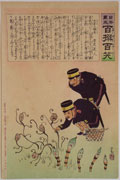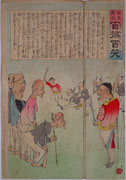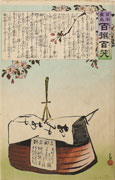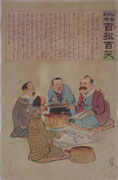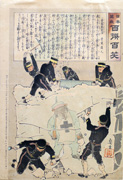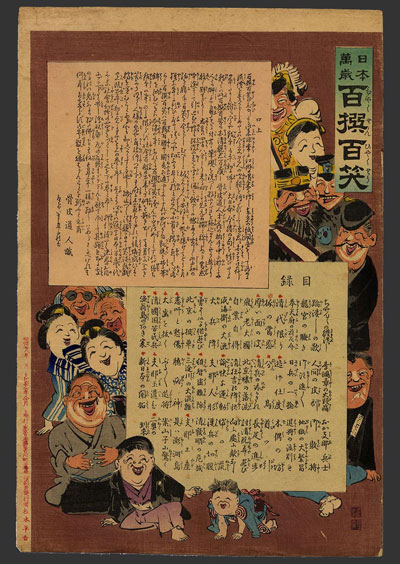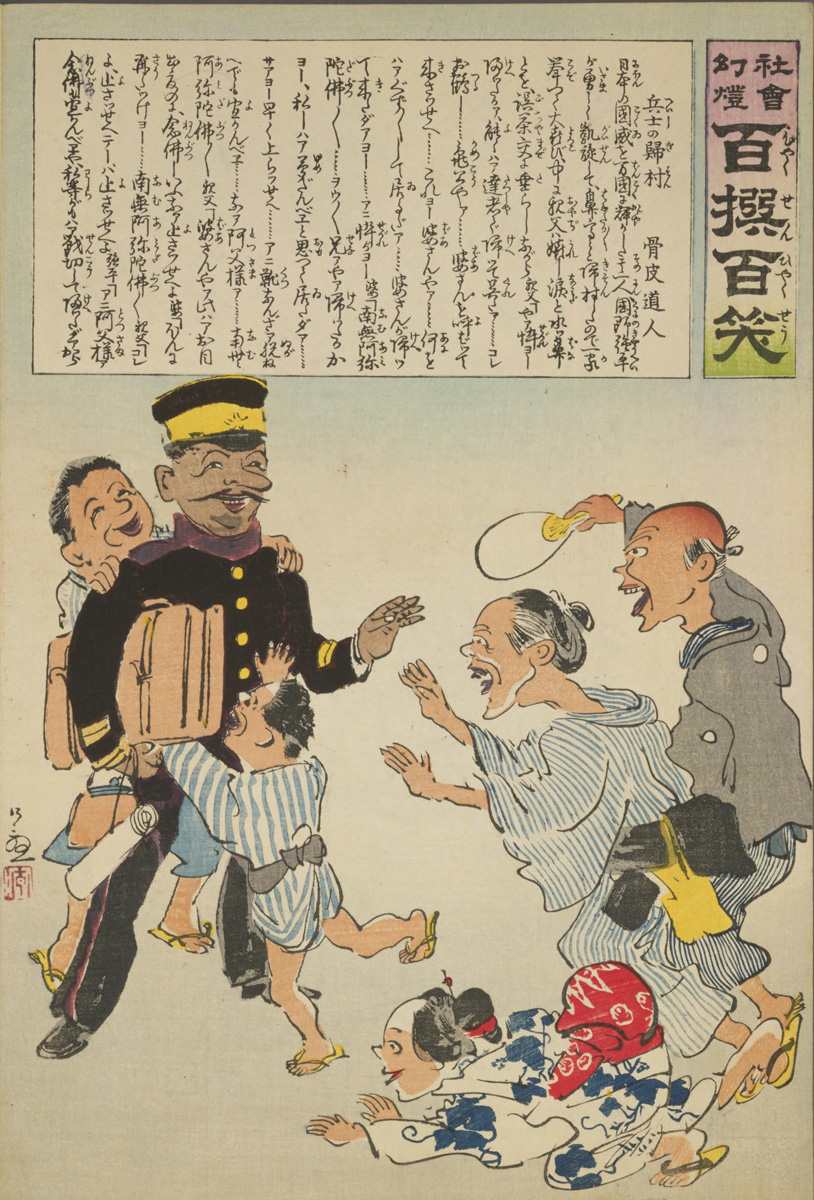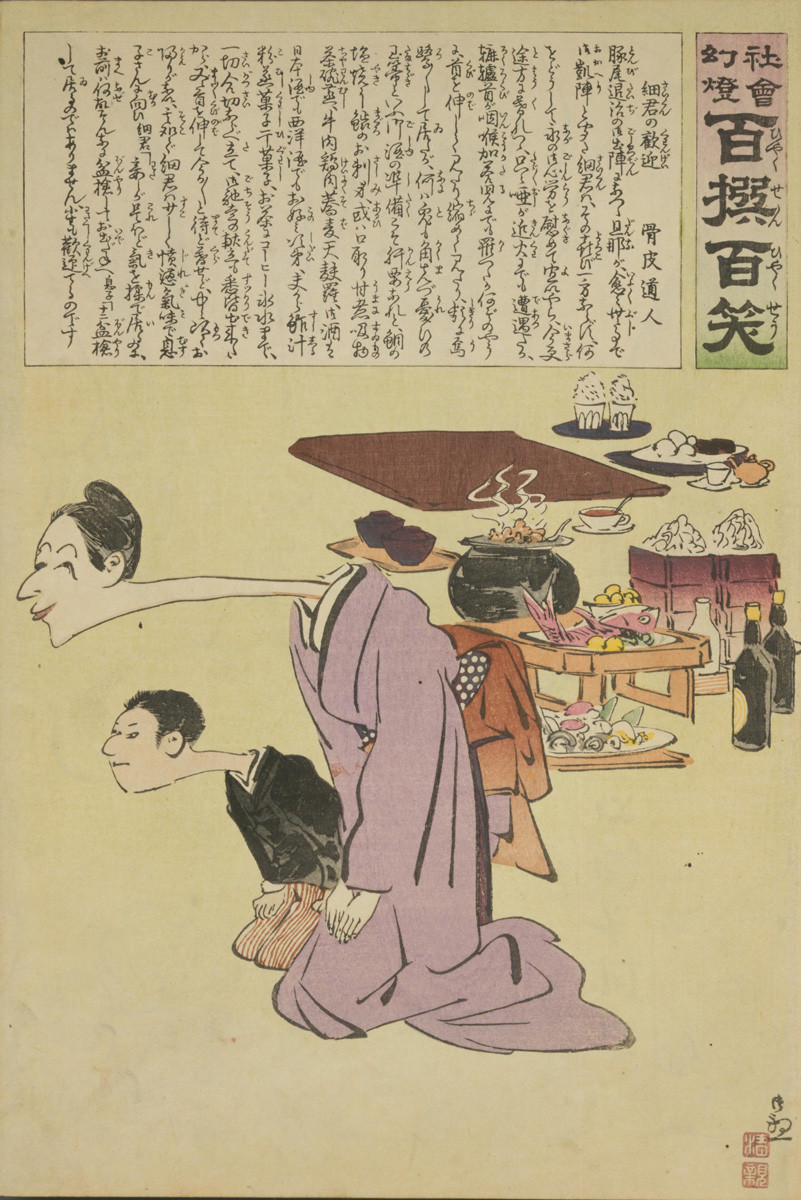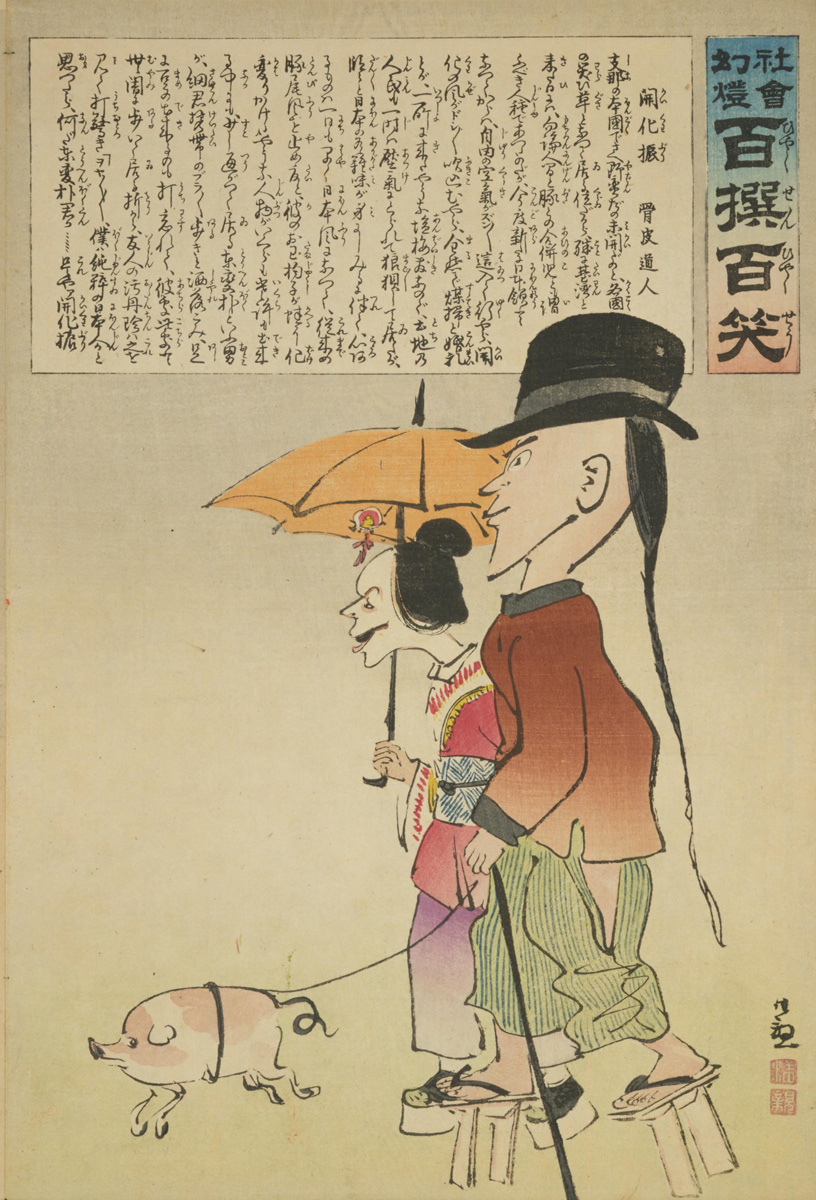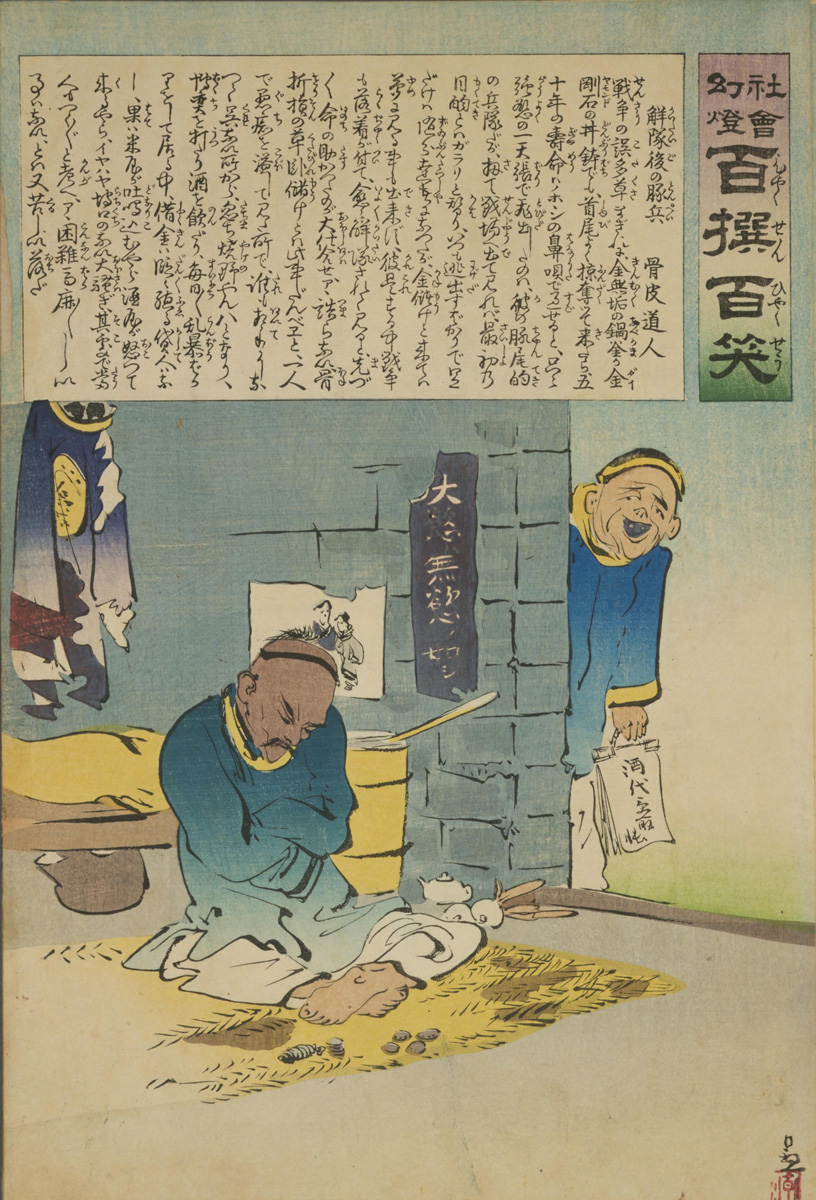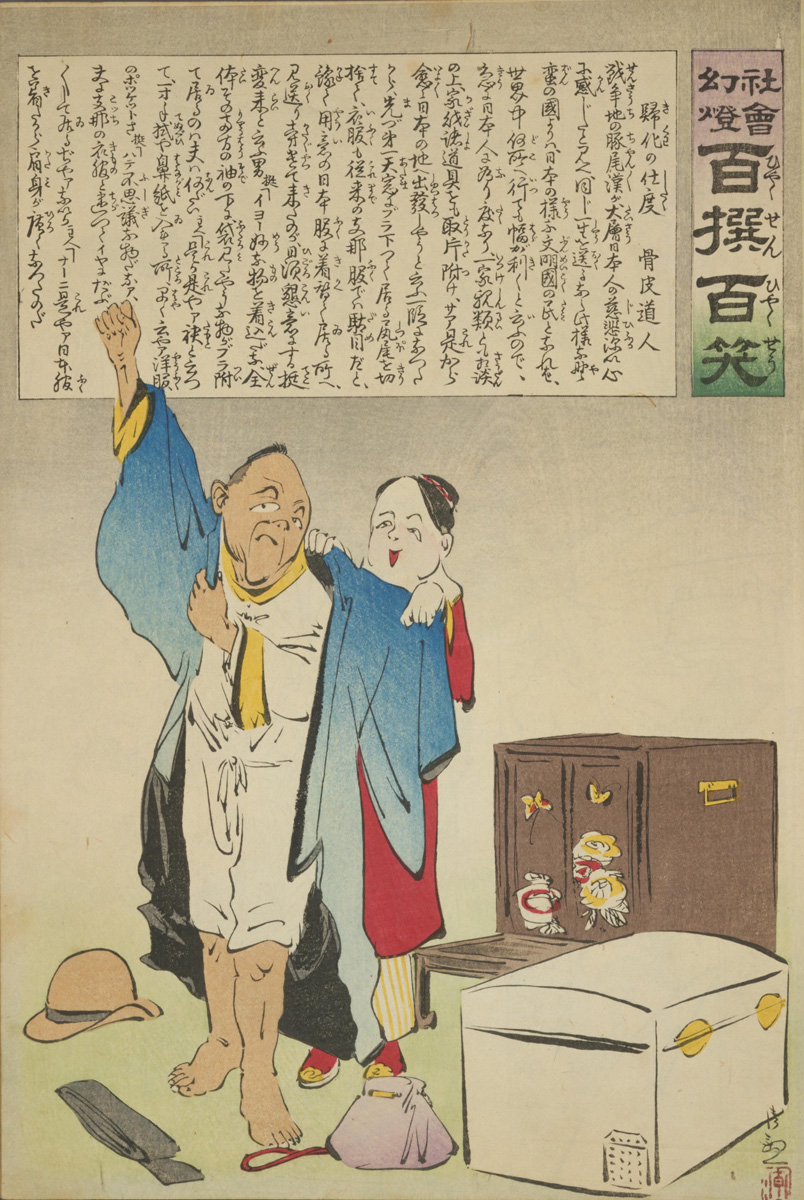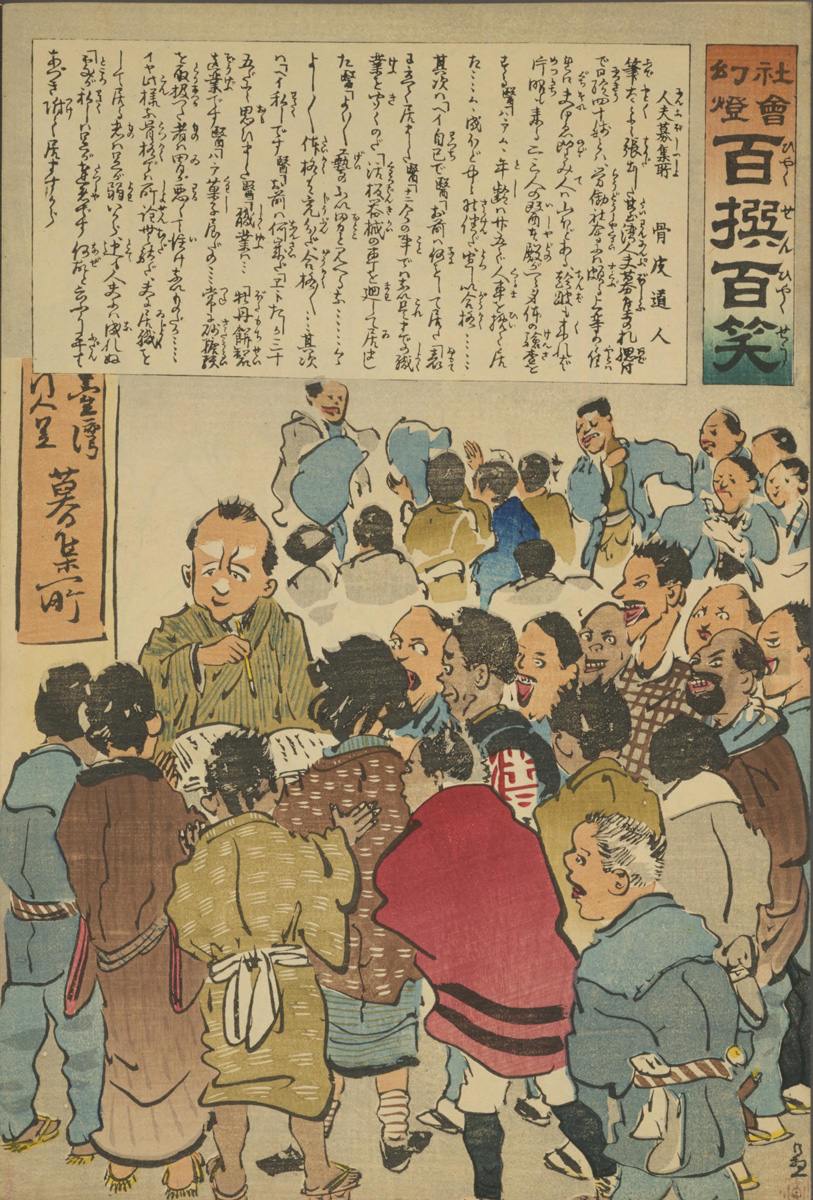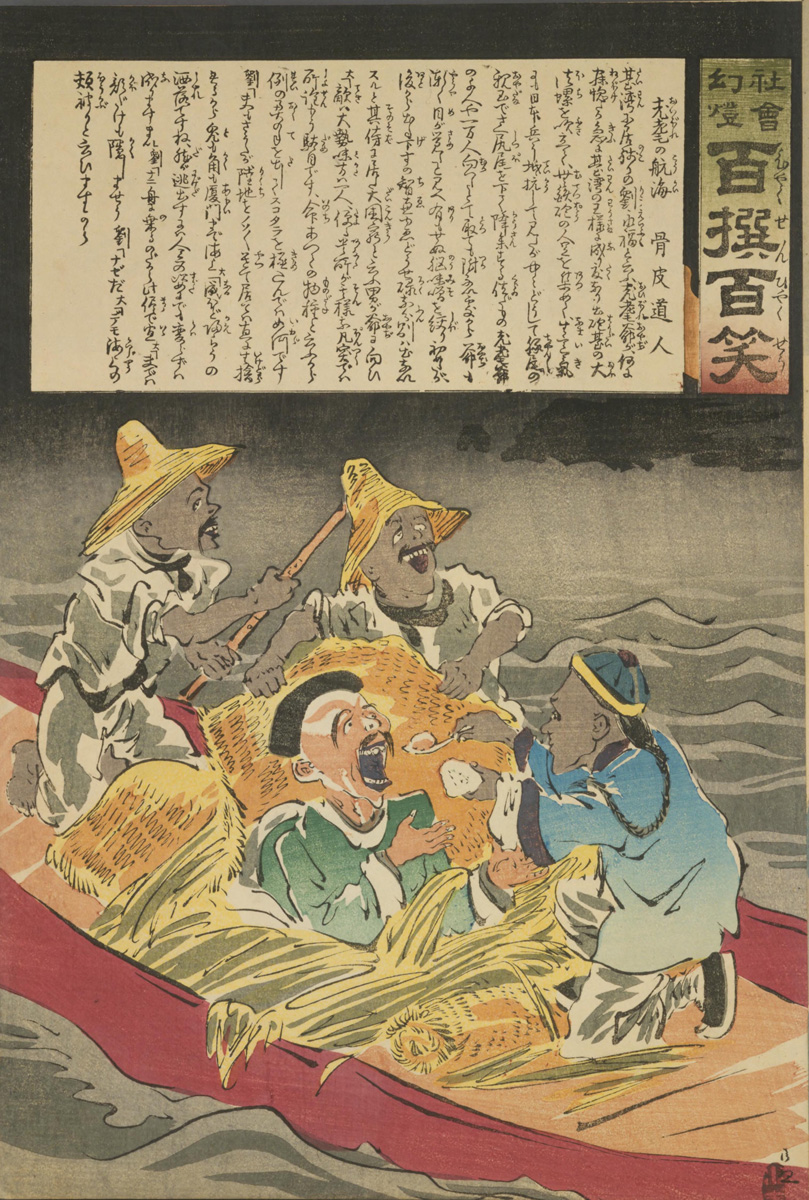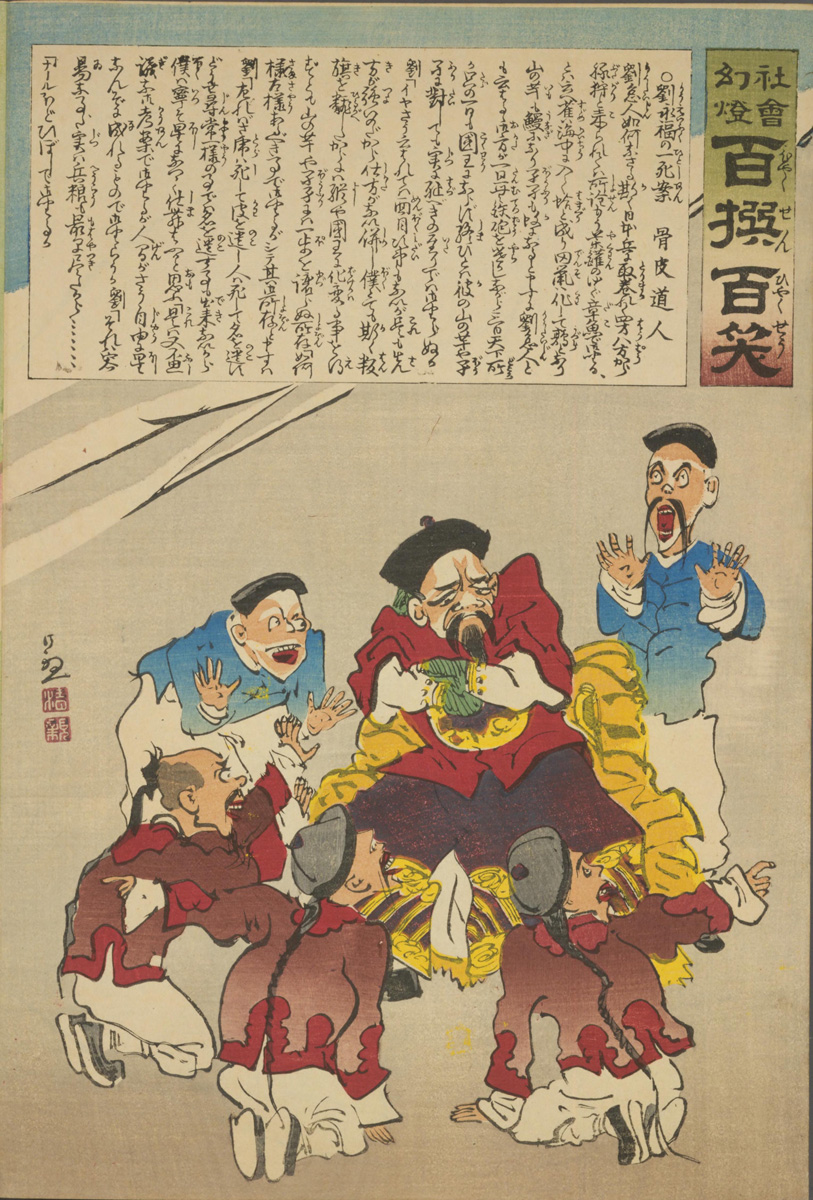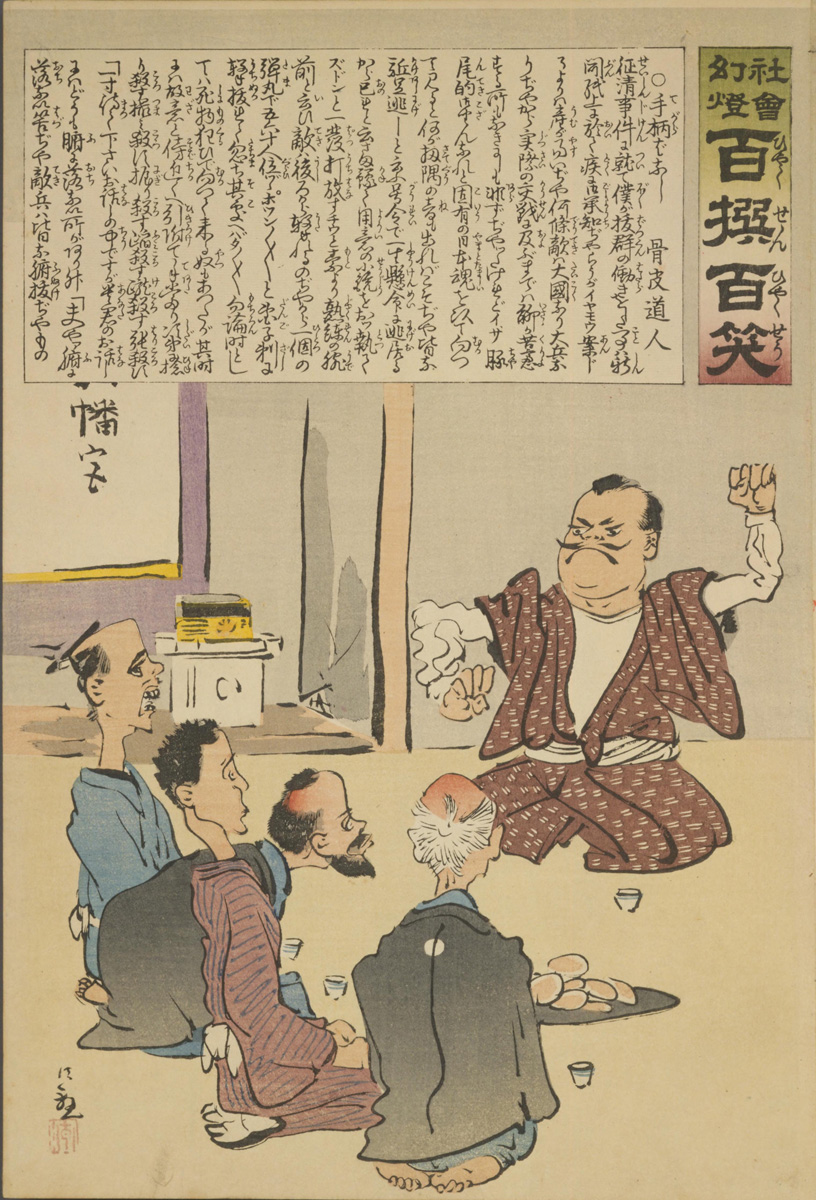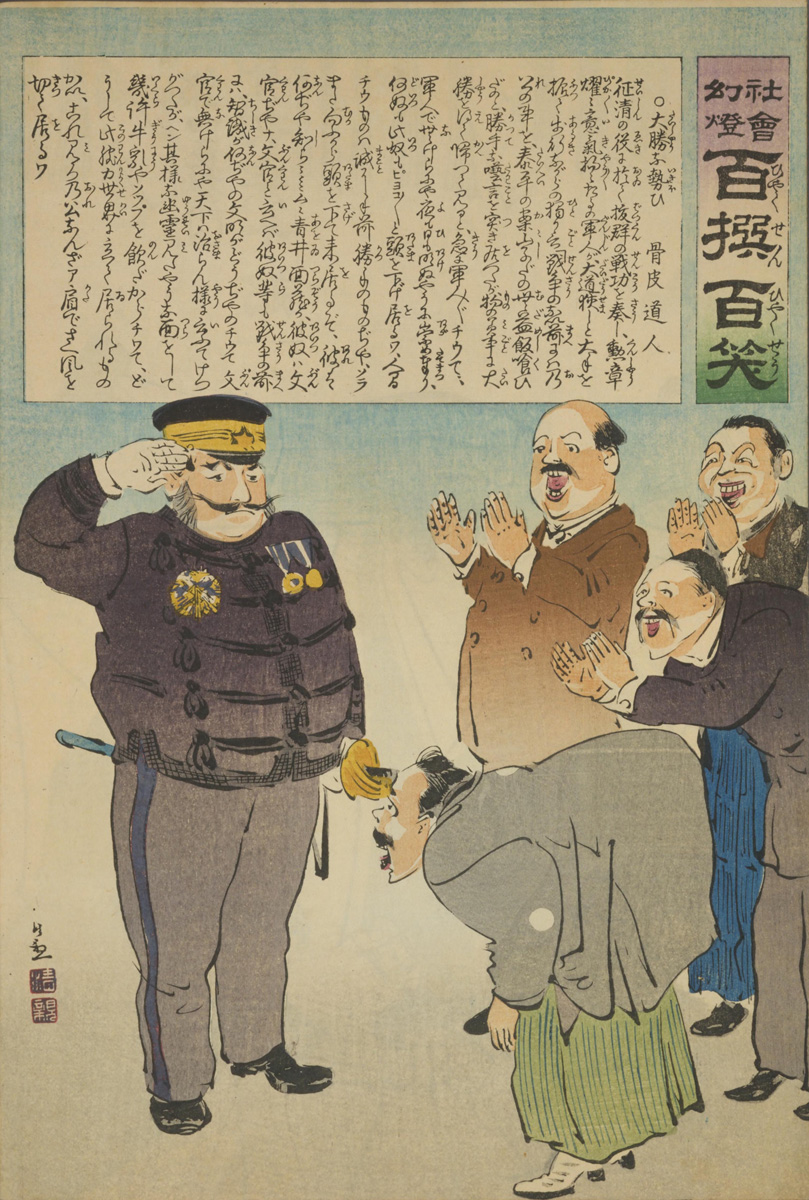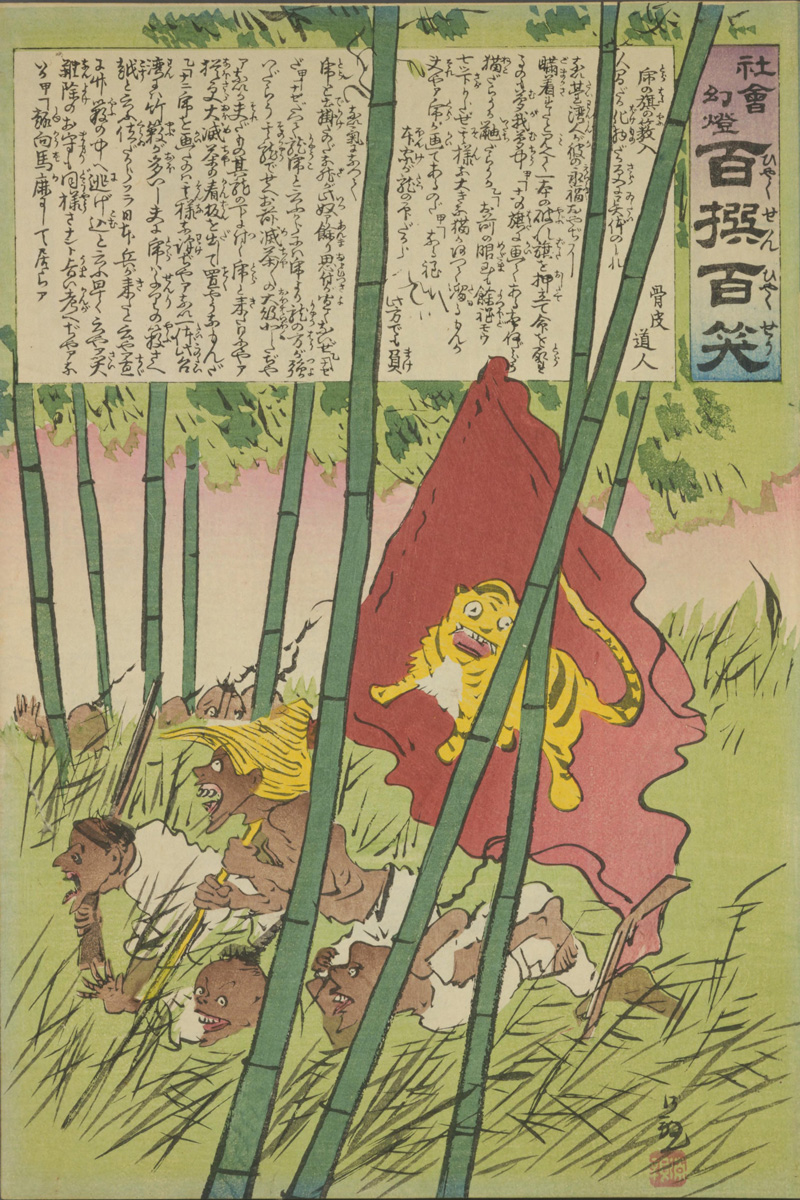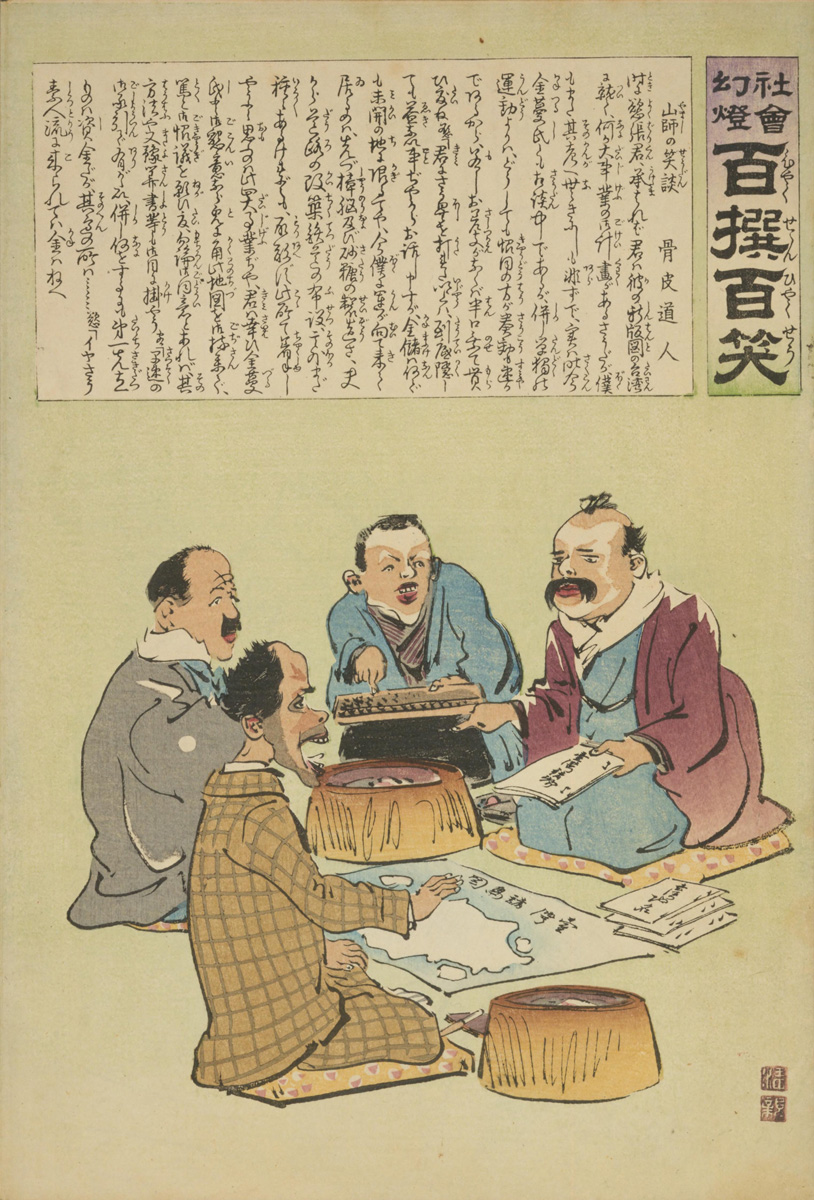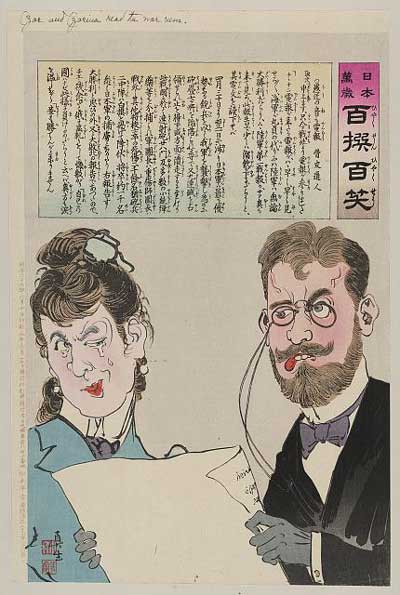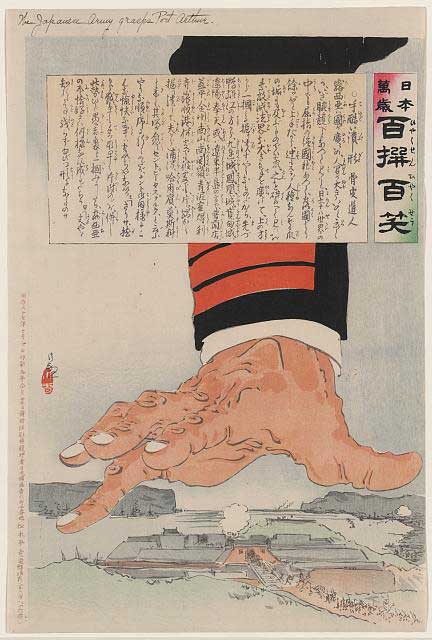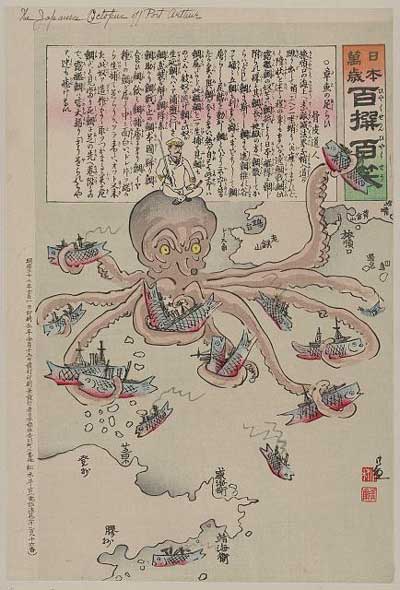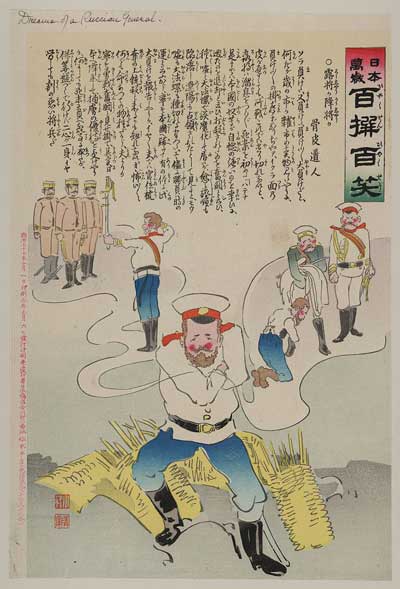The Three Part Series
“One Hundred Victories, One Hundred Laughs"
[百選百笑 - Hyakusen hyakusho]
by Kobayashi Kiyochika
UNDER REVISION
WORK-IN-PROGRESS
(as of July 6, 2015)
Prints in Collection
Prints from the series Long Live Japan: One Hundred Victories, One Hundred Laughs
[Sino-Japanese War]
September 1894IHL Cat. #1218
December 1894
IHL Cat. #380 Hell is Booming
December 1894
December 1894
February 1895
Mice in a Trap
April 1895IHL Cat. #44
Tearing Weeds Out In Peking
April 1895IHL Cat. #234 Turmoil at River Sanzu
May 1895
IHL Cat. #247
New Army Recruits
August 1895IHL Cat. #1043
Prints from the series Magic Lantern Society: One Hundred Victories, One Hundred Laughs
[Sino-Japanese War]
IHL Cat. #273
Prints from the series Long Live Japan: One Hundred Victories, One Hundred Laughs
[Russo-Japanese War]
IHL Cat. #1058
Extermination of the Black Russian Bear
May 1904
About The Series "One Hundred Victories, One Hundred Laughs"
Introduction
The series title Hyakusen hyakushō, literally One Hundred Victories, One Hundred Laughs, is a pun on the expression "One Hundred Battles, One Hundred Victories" (both pronounced "Hyakusen hyakushō").1 The series was issued in three parts and presented parodies of the enemy, the Chinese in the Sino-Japanese War of 1894-1895 and ten years later the Russians in the Russo-Japanese War of 1904-1905. The first part of the series titled Long Live Japan: One Hundred Victories, One Hundred Laughs, consisting of fifty prints, was issued between September 1894 and August 1895. The second part of the series titled Magic Lantern Society: One Hundred Victories, One Hundred Laughs, consisting of twelve prints, was issued between November 1895 and December 1896. Both of these parts parodied (often in a racist manner) the Chinese people, leadership and war effort. The third and last part of the series, consisting of eight-six prints, used the same title as the first part Long Live Japan: One Hundred Victories, One Hundred Laughs. Issued between April 1904 and April 1905, the prints parodied the Russian war effort. Overview of the Entire Series One Hundred Victories, One Hundred Laughs
Title
[war depicted]Date Range 50
plus 1 table of contentsSeptember 1894 -
August 189512 November 1895 -
December 1896
86 April 1904 -
April 1905
Political Cartoons
While all three parts of the series "amounted to satirical political cartooning" the first two parts "introduced a new level of ridicule and mockery to depictions of theChinese foe. Such depictions were comparable, in sometimes ironic ways, to the 'anti-Oriental' cartoons produced by the English, Americans, andEuropeans at this same time."3
In a 2011 exhibition titled "Pictures of Power, Japanese Woodcuts as Propaganda," the Östasiatiska museum commented "Kobayashi Kiyochika's series of woodcuts, 'Long live Japan; one hundred victories, one hundred laughs' from the Sino-Japanese War (1894-1895) raises many questions about how images affect us, how they are able to mobilize violence and prevent us from feeling empathy for the designated enemy."4
1 Museum of Fine Arts, Boston website http://www.mfa.org/collections/search_art.asp?recview=true&id=155588&coll_keywords=meiji&coll_accession=&coll_name=&coll_artist=&coll_place=&coll_medium=&coll_culture=&coll_classification=Prints&coll_credit=&coll_provenance=&coll_location=&coll_has_images=&coll_on_view=&coll_sort=2&coll_sort_order=0&coll_view=0&coll_package=0&coll_start=11
2 Nishimori Takeki 西森武城 (1861-1913), was one of the chief comic writers for the newspaper Marumaru chinbun and often collaborated with Kiyochika, who was thirteen years his senior.
3 MIT Visualizing Cultures website "Throwing Off Asia," by John W. Dower http://ocw.mit.edu/ans7870/21f/21f.027/throwing_off_asia_01/kiyochika_manga_b.html
4 website of Östasiatiska museet (The Museum of Far Eastern Antiquities, Stockholm, Sweden) http://www.varldskulturmuseerna.se/en/ostasiatiskamuseet/exhibitions/previous-exhibitions/pictures-of-power-japanese-woodcuts-as-propaganda-/3 MIT Visualizing Cultures website "Throwing Off Asia," by John W. Dower http://ocw.mit.edu/ans7870/21f/21f.027/throwing_off_asia_01/kiyochika_manga_b.html
List of the 50 Prints from "Long Live Japan: One Hundred Victories, One Hundred Laughs" (First Part: Sino-Japanese War Series)
| Title (English) | Title (Japanese) | Date of Publication | |
| Table of contents | Mokuroku | Meiji 28 | |
| 1 | A shock for the Chinese guy | Chanchan no kimotsubushi | Meiji 27/9 |
| 2 | General Li´s splitting headache (A Big Headache for Li Hongzhang) | Rikōshō no ō-zutsū | Meiji 28 |
| 3 | Chinese / strange soldiers | Okashina heish | Meiji 27/9 |
| 4 | The Pestle-Song | Fumitsubushi no uta | Meiji 27/9 |
| 5 | Skinning people | Ningen no kawahagi | Meiji 27 |
| 6 | Total exhaustion / A big failure | (Ō-heikō) On-haishō | Meiji 27/11 |
| 7 | Hubbub in the dragon kings palace (Turmoil in Dragon’s Palace) | Ryūgū no sawagi | Meiji 27/11 |
| 8 | Newsflash! Newsflash! | Go-chūshin go-chūshin | Meiji 27/11 |
| 9 | Boom in the underworld (Hell is booming) | Jigoku no ō-hanjō | Meiji 27/11 |
| 10 | The incommodious Manchuria | Hōtenfu no ni-yakkai | Meiji 27/11 |
| 11 | A big aim for the Japanese army | Nippei no ichinen | Meiji 27/12 |
| 12 | Tearful goodbye of the beaten commander | Taishō no nakiwakare | Meiji 27 |
| 13 | The end of the Qing Dynasty / the succession | Shindai kagiri | Meiji 27/12 |
| 14 | Preparations for the flight | Nige-shitaku | Meiji 27/12 |
| 15 | The blockhead / Defense of the straw man | Dekunobō 木偶の坊 | Meiji 27/12 |
| 16 | Meandering pigs | Buta no tōwaku | |
| 17 | The snatching | Bundori | |
| 18 | Pulling the necks | Kubippiki | Meiji 27/11 |
| 19 | A thick-skinned face | Atsui tsura no kawa | Meiji 28/2 |
| 20 | An object lesson for the Chinese military (Making Chinese Soldiers Shiver) | Shinpei no hiyakasare | Meiji 28/2 |
| 21 | Quantum jump / A walk with long legs | Chōsoku no shinpo | Meiji 28 |
| 22 | An old Empire is flying away / is swept away | Tonda Rōdaigoku | Meiji 28/2 |
| 23 | Mademoiselle Chinas lament | Pekinjō no rakurui | Meiji 28 |
| 24 | Fun with modern toys | Tōsei omocha asobi | Meiji 28/2 |
| 25 | Thought luck! | Jigōjitoku | Meiji 28/3 |
| 26 | A moaning monologue in the Chinese kyogen | Shinkyōgen no kōjō | Meiji 28 |
| 27 | No enemy far and wide | Mukau tokoro ni teki nashi | Meiji 28 |
| 28 | Big fishing at Weihaiwei | Ikaiei no tairyō | Meiji 28/4 |
| 29 | A move of regret | Yukai na undō | Meiji 28 |
| 30 | Mice in the sack (Rats in a bag) | Fukuro no nezumi | Meiji 28/4 |
| 31 | The beaten commander | Ō-heikō | Meiji 28 |
| 32 | China dolls | Shinaningyō | Meiji 28/3 |
| 33 | Suicide of the Chinese soldier | Kanpei no seppuku | Meiji 28/3 |
| 34 | A vivid child´s play (Brave children playing) | Isamashii kodomo asobi | Meiji 28 |
| 35 | A clever protection against thievery | Tonchi tōnan-yoke | Meiji 28 |
| 36 | A new machine made in China | Shin-hatsumei no kikai | Meiji 28/4 |
| 37 | Tearing weeds out at Peking (Japanese soldier gathering young herbs in Peking) | Pekin no tsumikusa | Meiji 28 |
| 38 | Turmoil at river Sanzu (Rush at the River Styx) | Sanzu-gawa no ō-konzatsu | Meiji 28/5 |
| 39 | Chinese souvenirs | Shina miyage | Meiji 28 |
| 40 | Trouble and strife | Kan’u to Shūshō | Meiji 28 |
| 41 | The fearful goddess | Okubyōgami | Meiji 28 |
| 42 | These are the Pescadores (Penghu)! | Kore wa Hōkotō | Meiji 28/1 |
| 43 | Pulling out a big tooth | Daiba o nuku | Meiji 28 |
| 44 | The shivering commander | Buruburu taishō | Meiji 28 |
| 45 | Horrifying the straw man | Kakashi ni odoroku | Meiji 28 |
| 46 | The Chinese sorrow-army | Shinkoku konkuminhei | Meiji 28/8 |
| 47 | The juggler of the Chinese ball | Shinadamatsukai | Meiji 28/6 |
| 48 | Only abandoned houses on island Gyoōtō | Gyoōtō no akiie | Meiji 28 |
| 49 | Reclaiming land in New-Japan | Shin-Nippon no kaitaku | Meiji 28 |
| 50 | Arrival of the two brides/200 million [Tael] war reparation | Nioku no tōrai | Meiji 28 |
For images of the above 50 prints go to the website of the Waseda University Library http://archive.wul.waseda.ac.jp/kosho/bunko10/bunko10_05481/bunko10_05481.html
The 12 Prints from "Magic Lantern Society: One Hundred Victories, One Hundred Laughs" (Second Part: Sino-Japanese War Series)
兵士の帰村
Heishi no kison
Soldier returning to his village
November 3, 1895
Title or Description (English) | Title (Japanese) | Date of Publication | |
| 1 | 強兵の戦任力 | ||
| 2 | 海陸戦争勝技 | ||
| 3 | 仁川艦鯛の一網 | ||
| 4 | 泣き労れ | ||
| 5 | 章魚の足らひ | ||
| 6 | 埋へ工夫 | ||
| 7 | 迂露隊砲台 | ||
| 8 | 玉乗の死苦尻 | ||
| 9 | 影弁慶 | ||
| 10 | 飛だ人玉 | ||
| 11 | 苦露熊退治 | ||
| 12 | 逃露々々 | ||
| 13 | 掃ハ内埃ハ外 | ||
| 14 | 手強い兵士 | ||
| 15 | 敵兵の無守備 | ||
| 16 | 両国の大相撲 | ||
| 17 | 新釣狐 | ||
| 18 | 露都の縮表 | ||
| 19 | 遼東御勘弁 | ||
| 20 | 諸城を踏潰す | ||
| 21 | 飛だ迷案 | ||
| 22 | 手酷い潰し形 | ||
| 23 | 上等の死露物 | ||
| 24 | 得利寺の打毀れ | ||
| 25 | 危妙な旗ら気 | ||
| 26 | 露国の号外売 | ||
| 27 | 露将か降将か | ||
| 28 | 三国拳 | ||
| 29 | 奉天のチヨコ見勢 | ||
| 30 | 迂露々々艦 | ||
| 31 | 暴露製の安軍艦 | ||
| 32 | 割の宜い勝法 | ||
| 33 | 屠露気武者 | ||
| 34 | 医者にも困つた | ||
| 35 | 水雷艇の大当 | ||
| 36 | 小癪ツ危兵 | ||
| 37 | 露艦の閉口 | ||
| 38 | 敗艦の死末 | ||
| 39 | 露兵の弱無士 | ||
| 40 | 危険綱渡り | ||
| 41 | 愚迂の音も電報 | ||
| 42 | 溺合の馳走 | ||
| 43 | 浦汐の大困雑 | ||
| 44 | 難でも兵器 | ||
| 45 | 一本足の負物 | ||
| 46 | ちやんと落嬢 | ||
| 47 | 摩天嶺の弱襲 | ||
| 48 | 露将の震軍 | ||
| 49 | 大和玉の御馳走 | ||
| 50 | 戦捷翫弄物 | ||
| 51 | 吐胆の苦し身 | ||
| 52 | ヅドン勝 | ||
| 53 | 命の白い物 | ||
| 54 | 日露の太刀合 | ||
| 55 | 大兵降の自劣込み | ||
| 56 | 九連嬢の兵気 | ||
| 57 | 露西亜一流転手固舞 | ||
| 58 | ヨワールとアワテル | ||
| 59 | 大負に大薪 | ||
| 60 | 露兵の同死打 | ||
| 61 | 危夫人の大病 | ||
| 62 | 露将の首途 | ||
| 63 | 面白い苦夫 | ||
| 64 | 敵艦の大笑事 | ||
| 65 | 取られ砲台 | ||
| 66 | 日本兵の雷名 | ||
| 67 | 大歯の死術 | ||
| 68 | 三死の面怪 | ||
| 69 | おか支那逃振 | ||
| 70 | 危隊な大法螺 | ||
| 71 | 海賊船の破滅 | ||
| 72 | 降らぬ騒ぎ | ||
| 73 | 露兵の倒変木 | ||
| 74 | 苦しい網頼み | ||
| 75 | 胴背焼潰し | ||
| 76 | 敗北の御注進 | ||
| 77 | 旅順の玉なし | ||
| 78 | 露国の戦時観音 | ||
| 79 | 苦しい時の蟹頼み | ||
| 80 | 達磨大悲 | ||
| 81 | 大男の兵突張 | ||
| 82 | 大痴穢の鬼 | ||
| 83 | 滅茶負の亡霊 | ||
| 84 | 露艦の角兵衛 | ||
Prints from the 1904-1905 Russo-Japanese War Series
(note: the following prints are not part of the Collection)
(note: the following prints are not part of the Collection)
